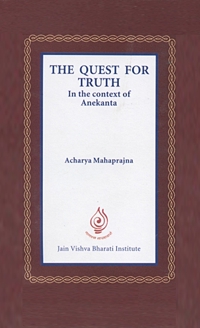
I once read somewhere that Jainism has the potential to be a world religion. In yet another context I read that Jainism was the world religion. I went deeper into these thoughts. I wondered if these thoughts had some truth in them. Does Jainism have the potential to become a world religion? Is it a world religion? I began to measure Jainism with the yardstick of a world religion. The religion, which has a large number of followers, can be a world religion. Jainism has not more than ten million followers. Then how can it be a world religion? The religion that has followers in all parts of the world can be called a world religion. The followers of Jainism are present only in a few countries. Then how can be it called a world religion? The religion that has followers from all sections of society engaged in all types of occupations, can be called a world religion. The followers of Jainism are primarily traders (the vaisya caste) then how can be it called a world religion?
Measured by these yardsticks I came to the conclusion that in its present form, Jainism is not a world religion. I went a step backward and tried to discern if Jainism had the potential to become a world religion. I was little overwhelmed. It is not surprising that I was overwhelmed considering that the religion towards which I was attached and which to me embodied the best could not be instantly taken to the top. I walked into the unknown territories of past. I wandered lost. At one point my step faltered. Some unknown voice whispered into my ear.
"All men are one."
I recognized the voice. I knew it belonged to Bhadrabahu, a commentator. I asked,
'Is it true that all men are one?'
"It is not imagination, it is really the truth."
"Then who divided man."
"Man did."
"Is this division God-made?"
"If it were God-made then why would this division be only in India. Is God bound within the geographical limits of the country?“
"What is the basis?"
"Vedic seers established the four varnas for social organization. The basis of this division is for organization of society."
"Has this organization not contributed to the progress of society in India?"
"Why not? It is this organization that has kept the social tradition of employment and artistic heritage even in the absence of formal schooling systems."
"Then why did Mahavira denounce the system of castes?"
"The idea that one is born into a particular caste fostered the feelings of high and low and untouchability thus destroying the principle of equality. If under such a situation, equality among men had not been declared, it would have made the idea of non-violence meaningless."
Acharya Badrabahu was assuaging my curiosity to a certain extent. At that time my ears resounded with yet another voice.
"Man is a Brahmin by virtue of his action, is a Kshatriya by virtue of his action, is a Vaisya by his virtue of action and also a Sudra by virtue of his action."
I reflected on all this for two seconds. Then I asked Bhadrabahu,
"Is the fact that action decides caste not eloquent of the principle of equality among men?"
He said,
"This is not the only truth. It is only useful for organizational interaction. Man is just man. If he is acquiring knowledge he becomes a Brahmin. The same man in the same lifetime may pick up arms for protection. Then he becomes a Kshatriya. If he trades, he becomes a Vaisya and when he is performing services he becomes a Sudra. This ever changing idea of caste does not construct barriers of high and low or of untouchability between men."
I thanked Acharya Badrabahu with humility and moved on. Crossing milestones of the past, I reached Indrabhuti Gautam. He was the eldest pupil of Mahavira and also the most significant commentator on the teachings and principles of Bhagawan Mahavira. Entering the subtle world I established contact with him and presented my problem.
"Lord! You were, by birth, a Brahmin who was well versed with Vedas. Then why did you accept tutelage under Mahavira?"
By saying that it is quite possible for a person ordained into Jainism not to find liberation and equally for a person ordained into any other religion to find liberation, Mahavira presented the irrelevance of rituals and the indivisible form of religion.
Religion is the purity of the inner soul. Therefore it is not bearing on caste, creed or ritualistic tradition. And yet the exterior form of religion presents itself in ritual and so caste gets associated with it. Mahavira kept the door to his religion's domain open to people of all castes and creeds. He would never have imagined that his religion would get associated with any creed or caste and thus close its doors on some people. And yet time wove such events that turned Mahavira's concept of oneness among men to differences among men. We can present Mahavira's principle of oneness among men to the whole world. But we cannot present the contemporary practices of Mahavira's religion as an example of human oneness to the world. Non-possessiveness (aparigraha) is a significant principle of human oneness. This can be presented to the entire world as a lofty principle but the Jain society cannot be held as an example of this principle. Multifaceted reality (anekanta) is another significant principle of human oneness. This can be presented as a tool to find solutions to the problems of the world. But the contemporary world of Jains cannot be cited as the followers of relativity or equanimity. Observing this conflict between principle and conduct the question that arises is:
- Is this principle only followed at the intellectual and emotional level and not at the practical level?
- If it is not to be applied at the practical level then what is its use?
If it is practical why is the Jain community not following it?
Jain society has been so greatly influenced by the events of time that it could not remain the ground for Mahavira's valuable principles. Today, the need is for the kind of Jain community that would represent Mahavira's valuable principles and would qualify to be the heir to his religion. The followers of these principles can be located in any section of the world.
From this point of view it can be said that Jain dharma has the potential to be a world religion.
 Acharya Mahaprajna
Acharya Mahaprajna


